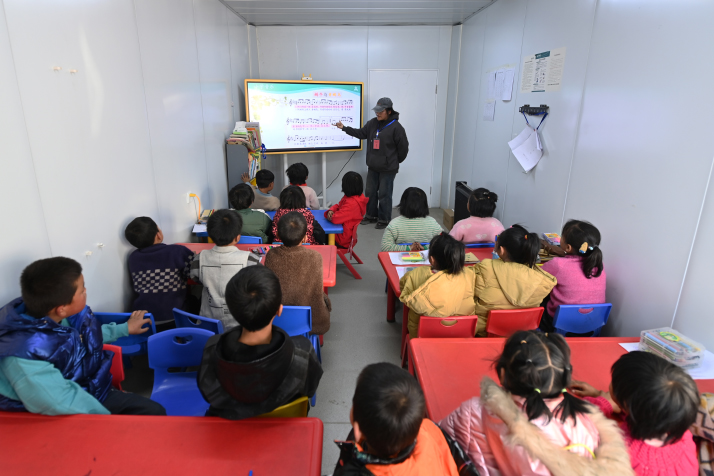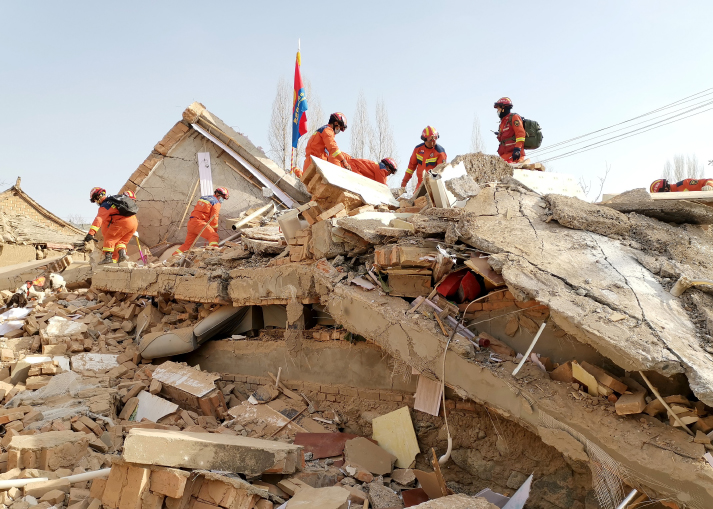| China |
| About the devastating earthquake that hit northwest China | |
|
|
 Students attend class in a temporary classroom in Dahejia Town of Bonan-Dongxiang-Salar Autonomous County of Jishishan, Gansu Province, on December 27, 2023 (XINHUA)
In the dark of night, the smartphone of a resident surnamed Qin in Bonan-Dongxiang-Salar Autonomous County of Jishishan in Gansu Province received an earthquake alert. The time was 11: 58 p.m. The date was December 18, 2023. It was one minute before the intense tremors started rattling this mountainous area in northwest China. Promptly, Qin jumped to his feet, woke up his family and ran. As they were making their way out of the house, the earthquake knocked the television in their living room to the floor. From their home on the 16th floor of an apartment building, the family rushed down the emergency stairs. At minus 12 degrees Celsius, it was freezing outside. People were pouring out of buildings. Some wearing thick down jackets, some wrapped in blankets, some wearing slippers. A deadly shake Soon, it was confirmed that an earthquake measured 6.2-magnitude just hit, and the epicenter was Jishishan's Liugou Township. The earthquake struck at a relatively shallow depth of 10 km, roughly 5 km from the provincial boundary with Qinghai Province, the China Earthquake Networks Center (CENC) said. The quake triggered at least one landslide. The tremors reverberated through Gansu and affected neighboring Qinghai. The seismic impact was also felt by regions in Sichuan Province of southwest China, as well as Shaanxi Province and Ningxia Hui Autonomous Region in northwest China. In and around the epicenter, damage was done, in varying degrees, to residential structures and essential infrastructure related to water, electricity, communication and road networks. Emergence responses were activated quickly. Units from the People's Liberation Army's Western Theater Command, armed police and fire and rescue departments stationed in neighboring areas of Gansu, swiftly moved to action. Within a matter of hours, thousands of troopers and firefighters reached the hard-hit area to begin vital tasks, including search and rescue, road clearance and electricity infrastructure repair. Straightaway, the Chinese Government allocated emergency funds and resources to the affected areas, delivering vital assistance such as food, water, blankets and medical supplies. The Earthquake Relief Command of the State Council and the Ministry of Emergency Management elevated the national earthquake emergency response to Level II, the second highest level of preparedness. In addition to government effort, non-government organizations also offered helps. When Su Jianjun, a resident of Lanzhou, capital of Gansu, felt the shaking and learned that it was an earthquake, his immediate reaction was to check the group chat of the local Blue Sky Rescue Team on Weixin, China's ubiquitous superapp. He is a member of the team, also known as China's largest non-profit civil emergency rescue organization. "My teammates were urgently calling for members who could head to the disaster area for rescue operations right away," Su told Chinese newspaper People's Daily. Within five minutes, more than 30 team members volunteered, and Su was among them. He quickly said goodbye to his family and gathered essential tools and supplies from the team's base before leaving Lanzhou to head directly to the epicenter. Around 5 a.m. on December 19, Su and his team arrived at a village close to Liugou Township. Firefighters were already on the scene, pulling survivors from the rubble. At the Jishishan County People's Hospital, medical personnel were stretched to the limit as they raced against time to treat injured patients. The hospital's observation unit, originally designed for only six beds, saw a stream of stretchers coming in and out. Numerous regions across China went on to mobilize disaster relief efforts, offering financial support and extending aid in the form of medical care, emergency rescue operations and essential supplies. Over 500 specialized technicians were dispatched to the affected area to assess the damage to residential structures and facilities, conducting emergency evaluations of building stability and managing crucial repairs. Hundreds of temporary relocation sites were set up to provide shelter for displaced residents. As of December 28, the earthquake had tragically claimed 149 lives, including 117 in Gansu and 32 in Qinghai, alongside approximately 1,000 injuries reported. A memorial service for the victims of the earthquake was held in Jishishan on December 25.  Rescue workers search for victims in Dahejia on December 19, 2023 (XINHUA)
Costs and causes In terms of casualties, the earthquake was China's deadliest since the catastrophic 2010 quake in Yushu, Qinghai, which took 2,698 lives. Preliminary analysis suggests this seismic event to have been a thrust-fault quake, Gao Mengtan, an expert from the China Earthquake Administration, told newspaper Beijing Daily. Thrust-fault earthquakes generally occur when two slabs of rock are pushed together and the pressure overcomes the friction holding them in place. "The seismic zone is located at the northeastern periphery of the Qinghai-Xizang Plateau," Gao explained. "The region experiences the most severe earthquakes in the nation due to the uplift of the plateau and its subsequent northeastward thrust. Characterized by a widespread distribution of numerous reverse fault lines, this area exhibits a high degree of tectonic activity." Gao further added that the substantial loss of life in this instance can be attributed to the poor seismic resistance of buildings, the relatively high population density in the affected areas and the timing of the quake, which occurred when people were mostly asleep and unable to instantly get up and go. "The bitter cold also posed a challenge to the rescue efforts," he said. Frosty weather can create problems like ice-stuck ladders or equipment failure. With the search and rescue work concluded on December 22, Gansu's emergency management authorities announced that they were shifting their focus to treating the injured, resettlement efforts and debris removal in quake-affected areas. According to media reports, as of December 24, the impacted areas were gradually resuming schooling, work and production. The Gansu Provincial Department of Housing and Urban-Rural Development mobilized response teams to conduct emergency assessments of the affected houses. "The earthquake has highlighted the urgent need to improve the seismic resistance of residential dwellings in rural areas," Gao said. Ma Yandong, an official with Gansu's housing, urban-rural development and township construction authority, echoed Gao's statement. "The rural houses that collapsed or sustained severe damage in the quake were predominantly self-constructed with older architectural designs and inadequate seismic performance," he told Xinhua News Agency. He explained that these structures were primarily composed of earth and wood or brick and wood, featuring load-bearing walls made of either earth or bricks. The connection between the walls and the wooden framework was frail, rendering them less capable of withstanding high-intensity tremors. "In recent years, Jishishan has been actively promoting the renovation of dilapidated rural housing to address safety concerns in primary residential dwellings," Ma said, noting that the newly built or renovated rural houses remained standing during the earthquake. The Gansu authority pledged to finalize the selection of sites for residential housing and rural construction by January 15 and ensure that residential housing will be ready for occupancy by late October. (Print Edition Title: Rising From the Rubble) Copyedited by Elsbeth van Paridon Comments to yuanyuan@cicgamericas.com |
|
||||||||||||||||||||||||||||
|